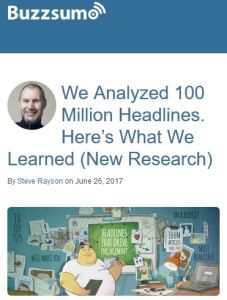
Steve Rayson
We Analyzed 100 Million Headlines. Here's What We Learned (New Research)
Buzzsumo, 2017
What's inside?
Why do some headlines grab your attention and others not so much?
Recommendation
What makes an enticing headline? Social search company BuzzSumo director Steve Rayson ran the numbers on 100 million headlines on the Internet between March 1 and May 10 of 2017. He discovered which phrases got the most engagement on Facebook and Twitter and offers some ideas about why they work so well. The good news is that you don’t have to write clickbait; in fact it’s better if you don’t. Readers want to gain insights, be informed and engage their emotions. But time is valuable, so they’re not going to click on a boring headline. getAbstract recommends Rayson’s advice to content authors aiming to increase their readership on social media.
Take-Aways
- In an analysis of 100 million online article headlines, several phrases emerged as winners in the race to capture readers and get them sharing your content on social media.
- The most effective phrases in headlines appeal to human desires to satisfy curiosity, gain insight or achieve a sense of belonging.
- Phrases that work well on Facebook may not do so well on Twitter.
- Many readers like headlines that are about themselves and others like them.
- List-style posts are also a popular format, especially when they itemize, say, “10 things.”
Summary
How do you get people to read and share your content on the Internet? One way is to have an enticing headline. In a Buzzsumo analysis of 100 million online article headlines, several phrases emerged as clear winners in the race to capture readers and get them sharing your articles, videos, lists and quizzes on social media.
On Facebook, the phrase “will make you” works best. When appearing in headlines such as “24 Pictures That Will Make You Feel Better About the World” or “6 Harsh Truths That Will Make You a Better Person,” that phrasing offers a reason to read the article, whether it’s to satisfy emotion or gain insight.
“Spend as much time writing the headline as you do an entire blog post or social post.” (content expert Anne Handley)
Emotion wins engagement on Facebook, as the high interaction rate of the phrases “tears of joy” and “most beautiful” shows. Phrases like “what happened next” and the most popular two-word phrase “goes viral” – which inspire curiosity and voyeurism – have also proved highly effective. But beware, in a fight against clickbait and articles that otherwise withhold information, Facebook has now begun demoting “what happened next” headlines.
“There is no simple formula or approach when it comes to popular headlines, you need to research and understand the headlines that resonate with your audience and industry.”
Quizzes are also popular on Facebook because they promise self-insight while affirming people’s intelligence and the significance of their life experiences. For similar reasons, people enjoy “tribal headlines,” such as “25 Things Only Teachers Will Understand,” that target readers as members of a special group, whether by age, profession or interest. Tribal headings are on the rise and increasingly target members of political groups. List-style posts are also a popular format, especially when they itemize, say, “10 things.”
On Twitter, headlines that offer to teach or explain something, such as “this is why” are popular with readers. These headlines suggest that insights and genuinely useful information will follow, rather than just empty clickbait. On Twitter, the focus is on explanatory headlines containing phrases such as “the truth about, things to know,” and uniqueness, featuring phrases like “for first time” and “is the new.”
About the Author
Steve Rayson is an investor in and director of BuzzSumo: a social analytics tool for content marketers, journalists, and those interested in finding great content and understanding influencer amplification.
This document is restricted to personal use only.
My Highlights
Did you like this summary?
Read the articleThis summary has been shared with you by getAbstract.
We find, rate and summarize relevant knowledge to help people make better decisions in business and in their private lives.
Already a customer? Log in here.

















Comment on this summary